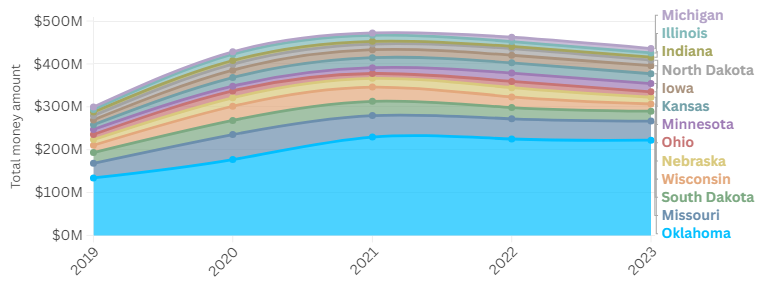
Although farm loans appear unaffected by President Donald Trump’s funding freeze, the administration’s rollback of DEI initiatives has cast uncertainty over USDA programs vital to socially disadvantaged farmers and ranchers.
From 2019 and 2023, the U.S Department of Agriculture provided $2 billion in critical financial support to these farmers and ranchers – those of color, women, and other underserved groups – in Midwestern states and Oklahoma to support farming operations and farmland development, according to USDA data.
Oklahoma, the nation’s top recipient for these loans, received nearly $1 billion over this same time period.
USDA updates in 2024 under former President Joe Biden’s administration expanded access to farm loans for socially disadvantaged farmers, including Indigenous producers. Trump’s dismantling of Diversity, Equity, and Inclusion (DEI) staff and initiatives has caused uncertainty about the future impact of these policy changes. Hard-fought by the Native Farm Bill Coalition, the 2024 changes are aimed at leveling the playing field for Indigenous agricultural producers.
Since the late 1980s, the USDA has implemented programs to assist socially disadvantaged producers — a category that includes women, African Americans, Native Americans, Hispanics, Asians and Pacific Islanders. Through its Farm Service Agency, the USDA offers farm ownership and operating loans to help these farmers. Farm ownership loans allow them to buy land, expand, and make improvements; operating loans cover everyday expenses like equipment, animals, feed, and fuel.
Oklahoma has the largest population of Native American farmers in the U.S.; states with large Indigenous farming communities, including Missouri, South Dakota, and Kansas, have also consistently received substantial portions of this funding. While public data does not break down loan distribution by group, Native American farmers make up a large share of agricultural producers in these states.
Loan support for minority farmers saw steady growth from 2019 to 2021, likely due to the economic strains of the pandemic. However, systemic barriers persist. According to data from the USDA’s Coronavirus Food Assistance Program, pandemic relief funds disproportionately benefited white farmers. Even before the pandemic, a 2019 government report found that minority farmers received far fewer farm loans than white farmers.